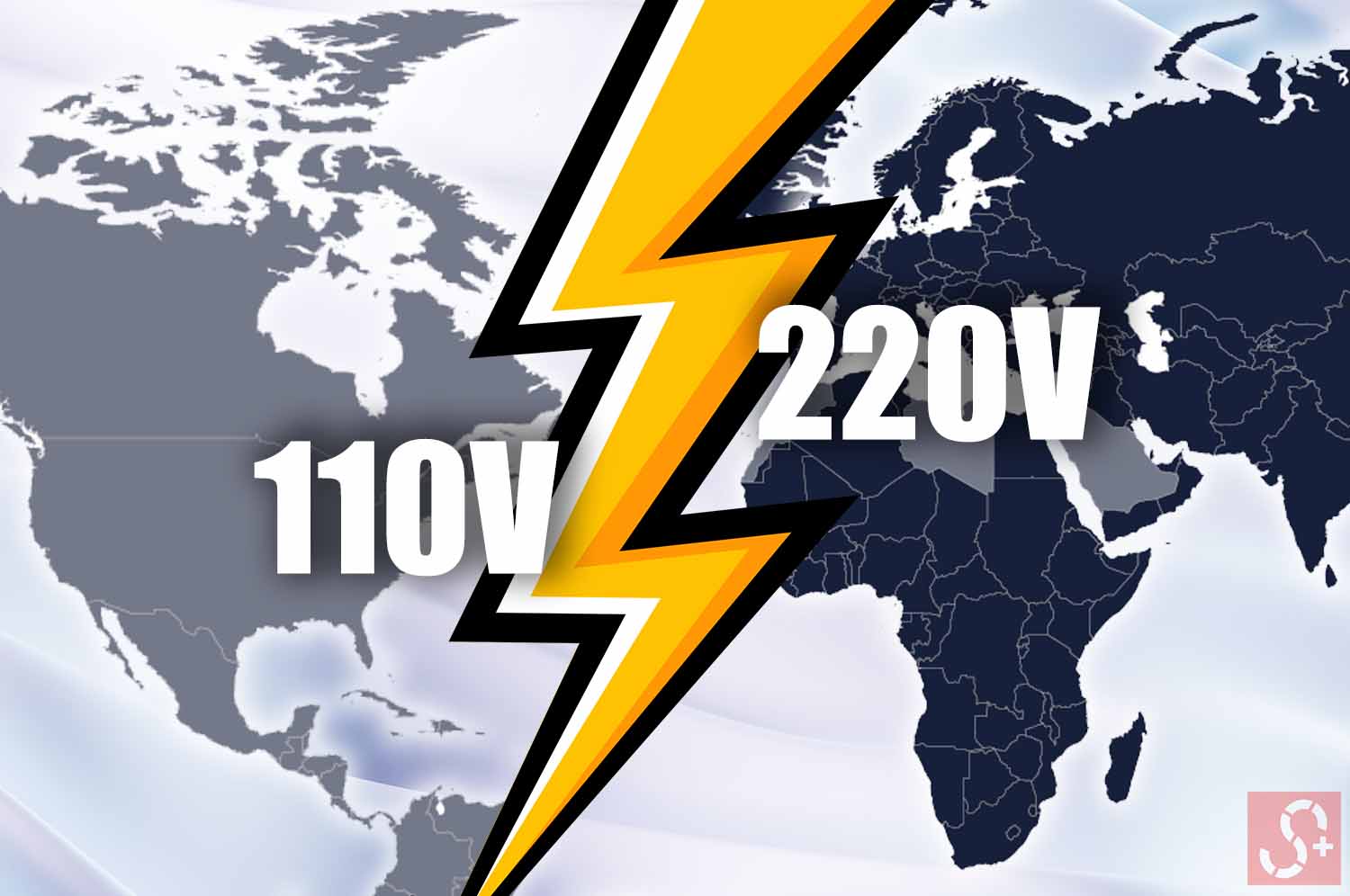In the United States, appliances are powered by 220V. But if you move abroad and take your devices with you, it is natural to think about the power supply and voltage. So let’s dive in deeper and understand everything in this guide.
Key Takeaways:
Countries in North America, the Caribbean, and certain areas of the Pacific use 110 volts at 60 hertz, whereas the rest of the globe uses 220 volts at 50 hertz. The voltage ranges covered by 110V and 220V are 100-125V and 220-250V, respectively. In many nations, you will also find both 110V and 220V outlets.
Continue reading till the end to learn about why countries use different power supplies like 110V or 220V, guidance on using your 110V device in countries with 220V, and more.
Why Do Some Countries Have 110V And Others Use 220V?
Thomas Edison, George Westinghouse, and Nikola Tesla helped construct the first modern transmission grid system in the United States in the 1880s.
And they decided to set the voltage at 110 volts for residential usage. Back then, 110 volts was ideal for the majority of electrical appliances, particularly lighting.
Although real voltages on our system typically run a bit higher, this is still the norm in the United States.
Nonetheless, attempts were made to enhance electrical systems while they were being constructed in other nations. For example, in Europe, corporations saw an opportunity to save money by switching to 220 from 110 volts for their electricity grids.
Electric companies can offer the same amount of power at a greater voltage with less current; think of a narrow stream running fast against a wider stream flowing slowly.
With lower current, thinner cables could be used. Copper, used in electrical wiring, is rather costly; therefore, increasing the voltage would result in cost savings.
In Europe, the standard for AC transmission voltage ranged from 220-240 volts. BEW was one of the first European businesses to provide 240-volt AC transmission. Interestingly, they went for 50 hertz rather than the more common 60 hertz.
Gradually, the continent as a whole came around to adopting this 50 hertz AC at a voltage range of 220 to 240 volts. British, French, Spanish, Portuguese, and other colonial powers introduced their voltage and frequency standards to their colonies in Asia and Africa. And that’s how the different power systems got adapted in different countries.
Why Is There No Standard Voltage Across The Globe?
Now, reading all these, naturally, questions arise like why we don’t have a unifying and standard electric system across the globe. Well, indeed, steps were taken in the past, but they didn’t have much success!
For instance, one of the earliest groups to try to standardize voltage and electrical outlets was the International Electrotechnical Commission (IEC).
In 1934, they organized a commission in conjunction with Holland’s International Questions Commission to address the issue of diverse socket designs and varying power factors like voltage and frequency.
World War 2 broke out just as the committee was beginning to make headway in this direction, thereby halting any efforts to standardize. Finally, in the 1950s, the IEC came to the conclusion that it was hard enough to agree on a single standard in a small part of Europe, let alone the rest of the world.
The quantity of these established systems grew too enormous to be altered and reconfigured again as time passed.
Also, advancements happened with the individual electrical transmission type and designs.
Because of the time and money put into developing their own proprietary systems, switching to a new standard would have required a complete overhaul of the electrical transmission infrastructure, from power production to distribution.
In short, North American nations standardized on 110-120 volt AC to reduce the likelihood of serious injury or death, but at the expense of reduced energy efficiency. Also, they went with the best frequency for alternating current transmission, 60 hertz.
To reduce power loss – European countries opted for 220-240 volts of alternating current (AC); however, their choice of 50 hertz as the operating frequency is questionable. In addition, when using a 50 Hz frequency, systems are more likely to flicker.
European countries, including Britain, France, Germany, Spain, and Portugal, set up electrical transmission lines throughout their colonies across Asia and Africa using the same voltage and frequency rating as they did at home.
So overall, for all these reasons, voltage, frequency, and electrical power outlets vary worldwide, and it appears that this will always be the case.
Is 110V Better Than 220V?
For home usage, 110V is better because most loads need less power. However, 220V is better for higher power purposes. Either way, there’s no difference in the cost to the end user because the electricity bills are based on Kilowatt-Hour and not the voltage.
If you choose between a 110V and a 220V appliance, the 220V version will utilize almost precisely half the current. That way, the amount of power and energy required to complete a task remains constant, provided that the appropriate transformer is utilized for the available voltage.
Therefore, there is no difference in the energy expenses of utilizing either option. Neither is notably less expensive to produce or use than the other.
Here’re some pros and cons of 110V:
| Pros: | Cons: |
| Lesser chances of electrocuting you | Thick cables are needed, which can be costly |
| More suitable for home usage | |
| Insulation requirement is relatively less. |
Here’re some pros and cons of 220V:
| Pros: | Cons: |
| Power can be transmitted at a lesser cost | It can be relatively risky. |
| More suitable for high power | |
| Simple wiring is required. |
Can 110V Appliances Be Used In 220V Countries?
You can use a 110V Appliance in countries that use 220V, provided you use a voltage converter. The voltage converter should be able to convert the power supply of 220V to the requirement of the device – 110V and thus allow the device to operate properly.
Caution: Never connect a 110V appliance directly to the connection that has 220V; otherwise, the board will get burnt.
For instance, if you use a North American Instant Pot In India, you have to be careful and avoid directly plugging it into the socket – because the voltage is different.
Another thing to note: The frequency (cycles per second) also varies from country to country, along with the voltage. Two common frequencies are used worldwide: 60 Hz (the United States) and 50 Hz (UK).
Most electronics are unaffected by the cycle shift since they convert AC voltage to DC voltage on the fly, and many gadgets can operate on either cycle.
Due to the frequency difference, a motorized appliance designed for 60 Hz may run more slowly when converted to 50 Hz.
To avoid having an analog device, like a clock, keep the wrong time; you should double-check the frequency.
Using a voltage converter is not recommended for use with single-frequency appliances like espresso machines and turntables. Regarding any questions, you can contact the product maker.
Furthermore, equipment that generates heat, such as heaters, steamers, and coffee warmers, should not be used with transformers.
The plug adapters are another distinction to consider. While most nations use the same two-prong style as the United States, this is not universal. Most nations use a different type of plug adaptor from the one used in the United States. In addition, multiple types of outlets exist in many nations.
So ensure you bring the appropriate plug adapters for your destination. If you need help determining which plug adapters to use, refer to this world-travel adapter plug guide.
How Can I Make My 110V Appliance Work With 220v?
To use your 110V household appliances from the United States in nations that utilize 220V electricity, you’ll need a step-down voltage converter or transformer.
On the other side, if you have a step-up voltage converter/transformer, you may use 220V appliances in the United States that normally require 110V.
Most voltage transformers may be toggled between step-up and step-down operation, making them extremely versatile.
Click here to check out one of the best voltage converters available on Amazon.








